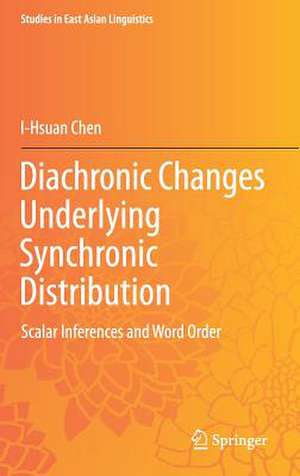Diachronic Changes Underlying Synchronic Distribution: Scalar Inferences and Word Order: Studies in East Asian Linguistics
Autor I-Hsuan Chenen Limba Engleză Hardback – 28 mai 2018
| Toate formatele și edițiile | Preț | Express |
|---|---|---|
| Paperback (1) | 694.69 lei 6-8 săpt. | |
| Springer Nature Singapore – 29 dec 2018 | 694.69 lei 6-8 săpt. | |
| Hardback (1) | 700.94 lei 6-8 săpt. | |
| Springer Nature Singapore – 28 mai 2018 | 700.94 lei 6-8 săpt. |
Preț: 700.94 lei
Preț vechi: 824.63 lei
-15% Nou
Puncte Express: 1051
Preț estimativ în valută:
134.13€ • 138.37$ • 111.93£
134.13€ • 138.37$ • 111.93£
Carte tipărită la comandă
Livrare economică 27 martie-10 aprilie
Preluare comenzi: 021 569.72.76
Specificații
ISBN-13: 9789811301698
ISBN-10: 9811301697
Pagini: 223
Ilustrații: XII, 240 p. 39 illus., 25 illus. in color.
Dimensiuni: 155 x 235 mm
Greutate: 0.53 kg
Ediția:1st ed. 2018
Editura: Springer Nature Singapore
Colecția Springer
Seria Studies in East Asian Linguistics
Locul publicării:Singapore, Singapore
ISBN-10: 9811301697
Pagini: 223
Ilustrații: XII, 240 p. 39 illus., 25 illus. in color.
Dimensiuni: 155 x 235 mm
Greutate: 0.53 kg
Ediția:1st ed. 2018
Editura: Springer Nature Singapore
Colecția Springer
Seria Studies in East Asian Linguistics
Locul publicării:Singapore, Singapore
Cuprins
Introduction.- The Development of ‘One’-phrases as Minimizers in Chinese.- The Development of the Polysemous Fixed ‘One’-phrase in Mandarin Chinese.- The Emergence of Scalar Particles DOU and YE in OV Order in Mandarin Chinese.-‘One’-phrases as Minimizers in Numeral Classifier Languages.- Synchronic Variations: ‘One’-phrases as Minimizers in Modern Mandarin Chinese.- Conclusion.
Notă biografică
I-Hsuan Chen is currently a postdoctoral fellow in the Department of Chinese and Bilingual Studies at the Hong Kong Polytechnic University. She received her PhD degree from the Department of Linguistics, University of California, Berkeley in 2015. Before joining the Hong Kong Polytechnic University, she held both research and lectureship positions at the Department of Linguistics and at the Department of East Asian Cultures and Languages, University of California, Berkeley. Her research areas include Chinese linguistics, historical linguistics, and cognitive linguistics primarily based on corpus analysis. She has published journal papers and book chapters covering synchronic and/or diachronic topics in semantics, syntax, and pragmatics in the field of Chinese Linguistics. She is a co-editor of the Cambridge Handbook of Chinese Linguistics, edited by Chu-ren Huang, Yen-hwei, and I-Hsuan Chen. The material for this book is based on her dissertation research, which was funded by the Chiang Ching-Kuo Foundation for International Scholarly Exchange.
Textul de pe ultima copertă
This book deals with synchronic variation in Chinese through a diachronic lens, based on the evidence from a quantitative, longitudinal corpus study. Departing from the traditional analysis in diachronic changes in Chinese linguistics, the cognitive constructionist approach employed in this book is able to capture incremental changes by combining syntax, semantics, and pragmatics. Topics such as word order, focus, scopes of quantifiers, information structure, and negation have been important issues in linguistics, but they are rarely integrated as a whole. The book makes their diachronic interactions available to the students and researchers in the fields of general and Chinese linguistics.
Caracteristici
Offers a new perspective, constructionist approach in the field of historical linguistics Provides empirical evidence from corpus analysis covering a 2000-year time span Offers cross-linguistic comparisons of scalar inferences in the East Asian classifier languages


